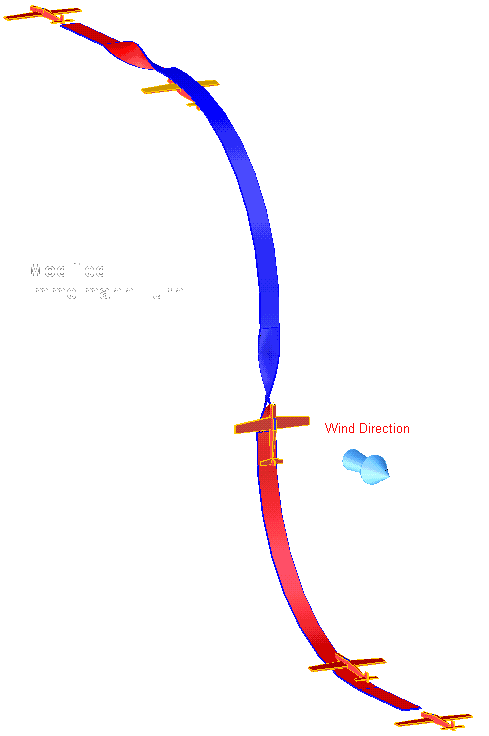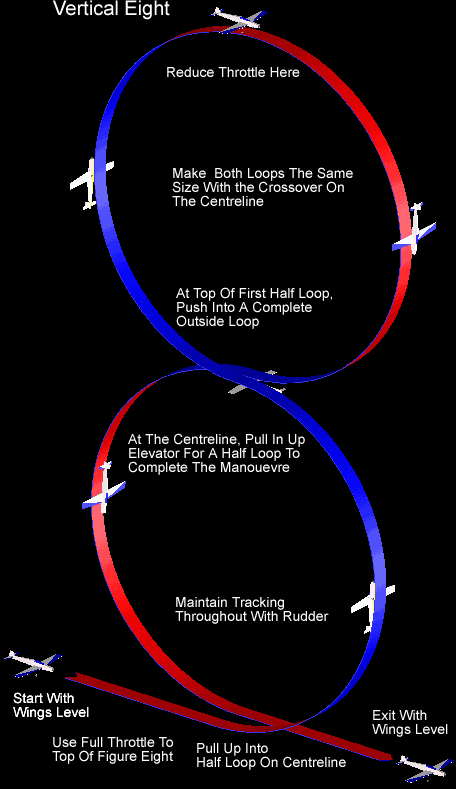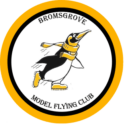Aerobatic Manoeuvres
| Loop |
|---|
| Bunt (Outside Loop) |
| Roll |
| Stall Turn |
| Spin |
| Immelmann Turn (Roll off the Top of a Loop) |
| Split S (Chop & Half Roll) |
| Cuban 8 |
| Half Cuban 8 |
| Reverse Half Cuban 8 |
| Avalanche (Roll at the Top of a Loop) |
| Hesitation Roll (2 point, 4 point, 8 point, 16 point etc etc) |
| Some More Variations On The Above! |
Overview
Fundamentally, there are only 3 basic control functions covering the 3 dimensional flight envelope – PITCH (Elevator), ROLL (Aileron) and YAW (Rudder). Thereafter, ALL aerobatic manouevres are a combination of one or more of these three.
Throttle control is also a very important part of aerobatics. Just whacking the throttle open for the duration of a manoeuvre is not very elegant or neat, and the speed build up in the downward plane will make you reach for the bicycle clips …..
Fly straight & level into wind
Increase power from cruise and nudge the nose down for extra airspeed
Pull UP elevator (the more you pull, the tighter the loop)
Centralise elevator when the model completes the loop and resumes straight & level flight
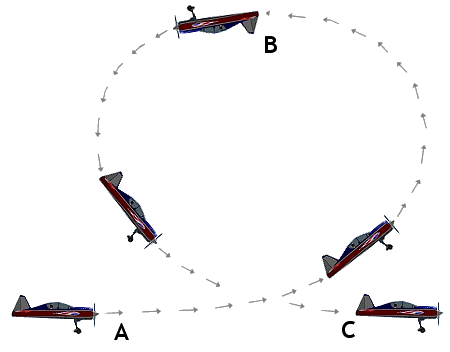
* Alternative 1 *
Ensure you have PLENTY of height for this manoeuvre
Fly straight & level into wind
Reduce power to tickover
Push DOWN elevator (the more you push, the tighter the loop)
Still holding in the DOWN elevator, increase to full power when the model becomes fully inverted
Centralise elevator when the model completes the bunt and resumes straight & level flight
* Alternative 2 – from INVERTED as below *
Fly straight & level into wind
Increase power to full throttle and half roll to inverted
Push DOWN elevator (the more you push, the tighter the loop)
Still holding in the DOWN elevator, reduce to tickover when the model becomes the right way up
Centralise elevator when the model completes the bunt, increase throttle to cruise, half roll and resume straight & level flight

Fly straight & level into wind
Increase power from cruise and nudge the nose down for extra airspeed
Momentarily pull UP elevator to bring the nose up (to avoid losing height in the manoeuvre)
Apply full Aileron (left or right – your choice)
Centralise aileron when the model completes the roll and resumes straight & level flight
You can convert into a barrel roll by holding in a small amount of UP elevator
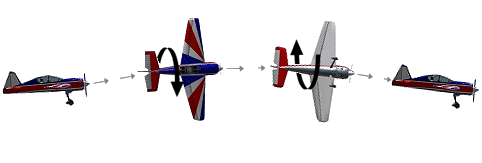
Fly straight & level into wind
Pull UP elevator until the nose is pointing up at about 60 degrees
Reduce throttle to a quarter or less
Wait until the model slows up and loses air speed, then apply full RUDDER and release when the model is pointing downwards
Apply UP elevator to resume straight & level flight
Note 1 > Leaving a small amount of throttle on makes the rudder ‘bite’ better
Note 2 > If the model has veered left in the climb, use left rudder, and vice versa,
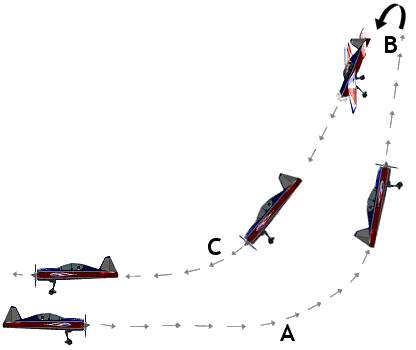
Ensure you have PLENTY of height for this manoeuvre if you get into trouble!!
Fly straight & level into wind
Reduce throttle to tickover
Slowly feed in UP elevator to raise the nose
Sharply apply full UP elevator and LEFT or RIGHT rudder
The model should flick into the spin and wait for rotation to begin
After the desired number of spin turns, CENTRALISE elevator and rudder
The spin should stop with the model point nose down, so apply UP elevator to resume straight & level flight
If the spin does not stop, you need to apply OPPOSITE RUDDER to arrest the spin, then you can proceed as above
If the spin does not stop and the model has adopted a ‘flat’ attitude, you need to apply OPPOSITE RUDDER and DOWN ELEVATOR to arrest the spin. This condition may require a plastic bag to put the bits in ….
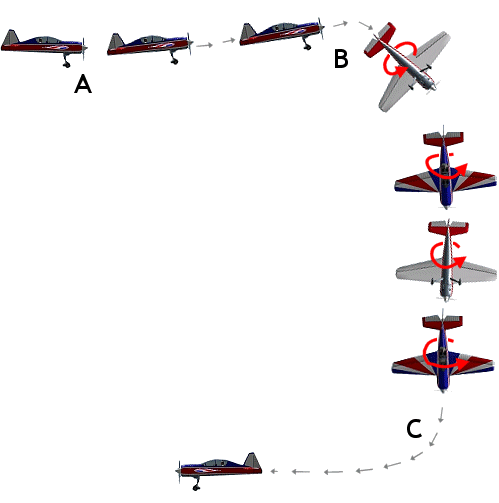
IMMELMANN TURN (ROLL OFF THE TOP OF A LOOP)
Named after the German WWI ace who first perfected this as a Fokker DR1 monoplane fighting tactic
Fly straight & level into wind
Increase power from cruise and nudge the nose down for extra airspeed
Pull UP elevator (the more you pull, the tighter the loop)
Halfway round the loop, at the top of the manoeuvre when the model is inverted, centralise elevator and HALF ROLL to straight & level flight
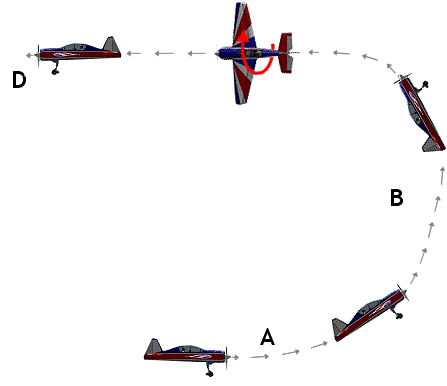
This is essentially the opposite to the Immelmann Turn above
Ensure you have enough height for the half loop
Fly straight & level into wind
Reduce power to tickover
Roll the model onto its back with AILERON
Pull UP elevator (the more you pull, the tighter the half loop)
Centralise elevator when the model completes the half loop, open the throttle to cruise setting and resume straight & level flight
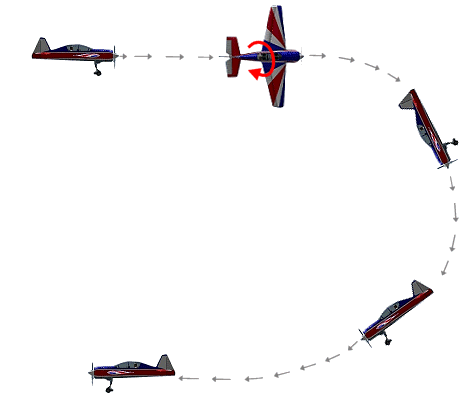
Fly straight & level into wind
Increase power from cruise and nudge the nose down for extra airspeed
Pull UP elevator (the more you pull, the tighter the loop)
When approximately two thirds of the loop has been completed, centralise the elevator and half roll with aileron to get the wings level
Again, pull UP elevator (the more you pull, the tighter the loop)
Again, when approximately two thirds of the next loop has been completed, centralise the elevator and half roll with aileron to get the wings level
Apply UP elevator to resume straight & level flight and reduce throttle for the cruise
Introducing a quarter hesitation point point in each half roll makes this manoeuvre look even more professional

Fly straight & level into wind
Increase power from cruise and nudge the nose down for extra airspeed
Pull UP elevator (the more you pull, the tighter the loop)
When approximately two thirds of the loop has been completed, centralise the elevator and half roll with aileron to get the wings level
Apply UP elevator to resume straight & level flight and reduce throttle for the cruise

REVERSE HALF CUBAN 8
Fly straight & level into wind
Increase power from cruise and nudge the nose down for extra airspeed
Pull UP elevator to get the nose to approximately 45 degrees, centralise the elevator and half roll
Pull UP elevator again to complete the final 2/3 of the loop
Resume straight & level flight and reduce throttle for the cruise
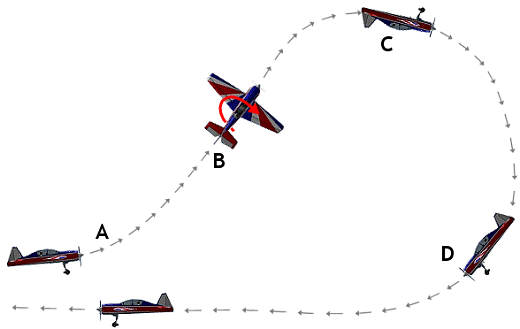
Fly straight & level into wind
Increase power from cruise and nudge the nose down for extra airspeed
Pull UP elevator (the more you pull, the tighter the loop)
Just before the top of the loop (at point B), centralise elevator and perform a complete aileron roll until the model is inverted again
Resume pulling UP elevator to complete the second half of the loop
Centralise elevator when the model completes the loop and resumes straight & level flight

The following are instructions for a 4 point roll
Fly straight & level into wind
Increase power from cruise and nudge the nose down for extra airspeed
Momentarily pull UP elevator to bring the nose up (to avoid losing height in the manoeuvre)
Apply full Aileron (left or right – your choice)
Centralise aileron momentarily when the model completes the first quarter of the roll
Apply full Aileron again (in the same direction of course)
Centralise aileron momentarily when the model completes the second quarter of the roll – you often need to feed in some DOWN elevator at this point to keep the nose UP whilst inverted
Apply full Aileron again
Centralise aileron momentarily when the model completes the third quarter of the roll
Apply full Aileron again
Centralise aileron when the model completes the roll and resumes straight & level flight
You can of course add as many hesitation points as you like – the more you add the harder it becomes of course
You may need to feed in “top rudder” when the model is at knife edge at the first and third quarter roll points. Which rudder you feed in will depend on the direction of the roll. A LH hesitation roll will require RIGHT rudder at quarter one and LEFT rudder at quarter 3. A RH hesitation roll will require LEFT rudder at quarter one and RIGHT rudder at quarter 3.


